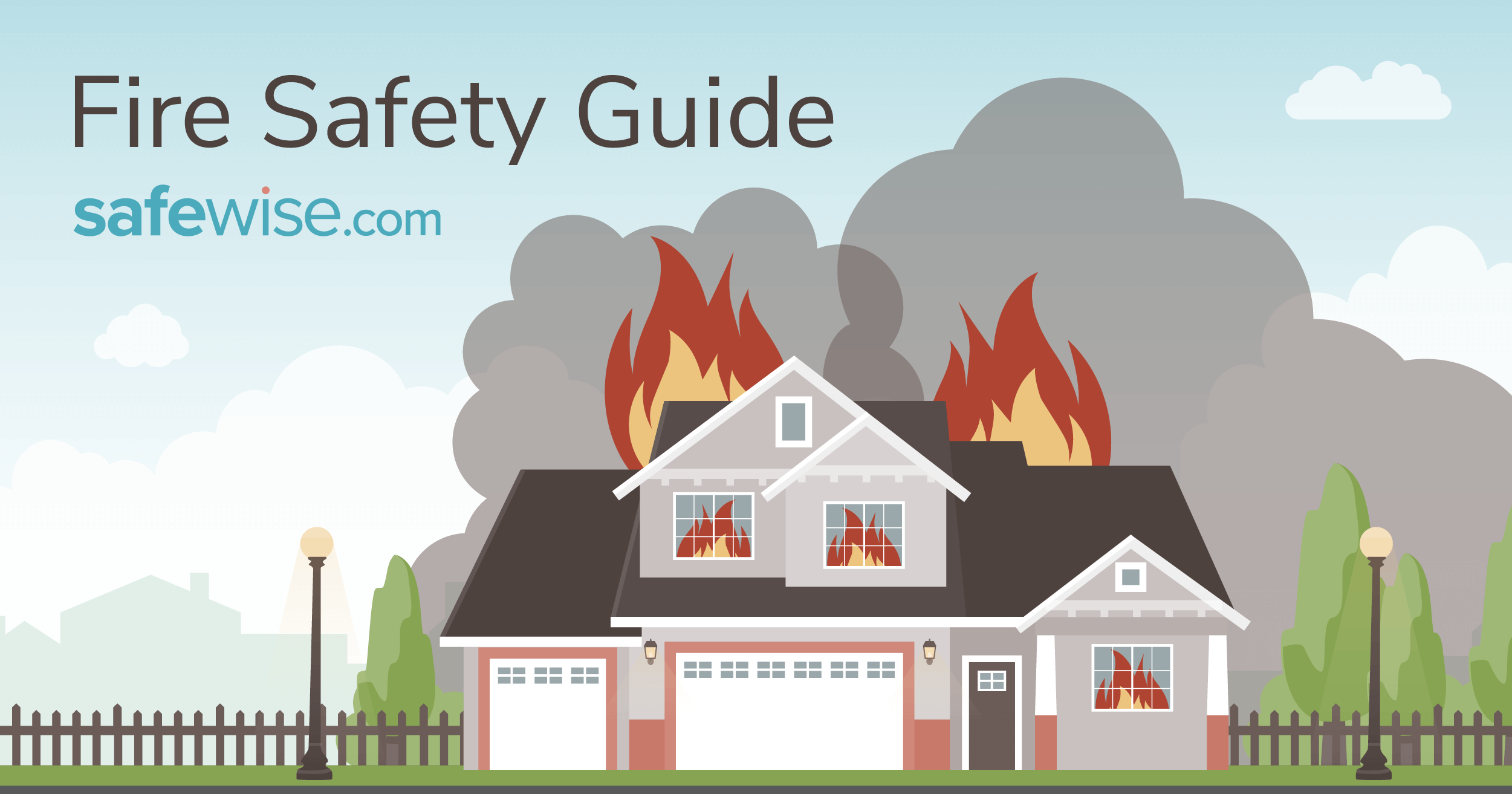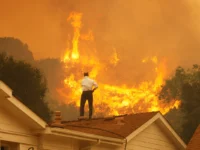Contents
- 1 1. Understanding Fire Hazards: Identifying Common Causes at Home
- 2 2. Fire Safety Basics: Essential Tips for Preventing Fires
- 3 3. Creating a Fire Escape Plan: Protecting Your Loved Ones
- 4 4. Smoke Alarms: The Early Warning System
- 5 5. Fire Extinguishers: A Vital Tool for Prompt Action
- 6 6. Electrical Safety: Preventing Fires Caused by Electrical Issues
- 7 7. Kitchen Fire Safety: Preventing Cooking-Related Fires
- 8 8. Heating Safety: Precautions for a Warm and Safe Home
- 9 9. Childproofing for Fire Safety: Protecting Young Ones
- 10 10. Fire Safety Equipment: Investing in Your Home’s Protection
In this article, we will provide you with essential tips and guidelines to safeguard your home from potential fire hazards. Whether you live in a house or an apartment, it is crucial to be prepared and knowledgeable about fire prevention and safety measures. We will cover various aspects, including fire prevention, emergency planning, and the importance of having the right fire safety equipment in place. So, let’s dive in and ensure the well-being of your home and loved ones!
1. Understanding Fire Hazards: Identifying Common Causes at Home
When it comes to fire safety at home, knowledge is power. Understanding the common causes of residential fires can help you take proactive measures to prevent them. Let’s explore some of the most prevalent fire hazards:
Cooking Accidents
Cooking is a leading cause of home fires. Unattended stovetops, overheating oils, and flammable items near the cooking area can all contribute to kitchen fires. Always stay attentive while cooking and keep flammable materials away from heat sources.
Electrical Malfunctions
Faulty wiring, overloaded circuits, and damaged electrical cords pose significant fire risks. Regularly inspect your electrical system, replace frayed cords, and avoid overloading outlets to minimize electrical fire hazards.
Heating Equipment
Improper usage or neglect of heating equipment can lead to devastating fires. Furnaces, space heaters, and wood-burning stoves require proper maintenance, adequate ventilation, and safe operating practices to prevent fire incidents.
Smoking
Smoking-related fires often occur when cigarettes are not fully extinguished or when smoking materials come into contact with flammable substances. If you smoke, ensure proper disposal of cigarette butts and avoid smoking in bed or when drowsy.
By familiarizing yourself with these common fire hazards, you can be more vigilant and take proactive steps to minimize the risk of fires in your home. In the following sections, we will delve deeper into fire safety practices to help protect your home and loved ones.
2. Fire Safety Basics: Essential Tips for Preventing Fires
Prevention is key when it comes to fire safety at home. By implementing a few simple yet effective practices, you can significantly reduce the risk of fires. Here are some essential fire safety tips to keep in mind:
Proper Handling of Flammable Materials
Store flammable liquids, such as gasoline and cleaning solvents, in well-ventilated areas away from heat sources. Ensure they are tightly sealed in approved containers to prevent accidental spills or leaks.
Careful Use of Candles
If you enjoy the ambiance of candles, make sure to place them on stable surfaces, away from flammable materials, and never leave them unattended. Consider using flameless candles as a safer alternative.
Mindful Cooking Practices
When cooking, never leave the kitchen unattended, especially when using high heat or oils. Keep flammable items like kitchen towels, oven mitts, and paper products away from the stovetop. In case of a grease fire, smother the flames with a metal lid or baking soda – never use water.
Safe Use of Electrical Appliances
Avoid overloading electrical outlets and extension cords, as this can lead to overheating and electrical fires. Unplug small appliances when not in use and regularly check cords for fraying or damage. Never run cords under rugs or furniture.
Regular Maintenance of Smoke Alarms
Test your smoke alarms regularly to ensure they are functioning correctly. Replace the batteries at least once a year, or consider upgrading to long-lasting, tamper-proof smoke alarms for added peace of mind.
By following these fire safety basics, you can significantly reduce the risk of fires in your home. However, fire emergencies can still occur, so it’s essential to be prepared. In the upcoming sections, we will discuss creating a fire escape plan and the importance of having the right fire safety equipment in place.
3. Creating a Fire Escape Plan: Protecting Your Loved Ones
Having a well-thought-out fire escape plan is crucial for ensuring the safety of everyone in your household. Here’s how you can create an effective fire escape plan:
Designate Meeting Points
Identify multiple meeting points outside your home where everyone can gather in case of a fire. Choose a primary meeting point, such as a neighbor’s house or a specific landmark, and an alternative meeting point in case the primary one is inaccessible.
Draw a Floor Plan
Create a floor plan of your home, marking all possible exits from each room. Make sure windows and doors can be easily opened in case of an emergency. Share this floor plan with everyone in your household and ensure they understand the escape routes.
Practice Regularly
Conduct fire drills at least twice a year to practice your fire escape plan. This will help everyone become familiar with the designated escape routes and meeting points. Remember to include children and elderly family members in these drills and assist them as needed.
Consider Special Circumstances
If you have young children, assign an adult to assist them during a fire emergency. Additionally, if there are family members with disabilities or mobility issues, ensure their needs are accounted for in the fire escape plan. Practice different scenarios to address these specific circumstances.
Stay Low and Crawl if Necessary
If there is smoke during a fire, stay low to avoid inhaling toxic fumes. Teach everyone in your household to crawl on their hands and knees if needed, as smoke rises and the air near the floor is generally safer to breathe.
Creating and practicing a fire escape plan is vital for everyone’s safety. In the next sections, we will discuss the importance of smoke alarms and fire extinguishers in enhancing your home’s fire readiness.
4. Smoke Alarms: The Early Warning System
Smoke alarms are a crucial component of any home’s fire safety system. These devices provide early warning in the event of a fire, giving you and your loved ones valuable time to escape. Here’s what you need to know about smoke alarms:
Placement and Installation
Install smoke alarms on every level of your home, including inside each bedroom and outside sleeping areas. Mount them high on walls or ceilings, as smoke rises. Follow the manufacturer’s instructions for proper installation and maintenance.
Testing and Maintenance
Test your smoke alarms at least once a month to ensure they are working correctly. Most models have a test button that you can press. Regularly replace the batteries, typically once a year, or when the low-battery warning chirps. Consider using long-lasting lithium batteries for added convenience.
Interconnected Smoke Alarms
For enhanced safety, consider installing interconnected smoke alarms. When one alarm detects smoke, it triggers all the interconnected alarms in your home, providing a comprehensive alert system throughout the house.
Smoke Alarm Sensitivity
Some areas of your home, such as the kitchen or bathroom, may generate steam or smoke from regular activities. To prevent false alarms, consider installing a smoke alarm with a hush feature or one specifically designed for high-sensitivity areas.
Regular Cleaning
Keep your smoke alarms clean and free from dust or debris, as this can impair their functionality. Gently vacuum the exterior of the alarm or use a soft brush attachment to remove any accumulated particles.
Smoke alarms are essential for early fire detection and can save lives. However, they are not the only fire safety equipment you should have in your home. In the following sections, we will discuss the importance of fire extinguishers and how to use them effectively.
5. Fire Extinguishers: A Vital Tool for Prompt Action
Fire extinguishers are essential tools that can help you take prompt action during a fire emergency. Understanding the different types of fire extinguishers and how to use them correctly is crucial for effective fire suppression. Here’s what you need to know:
Types of Fire Extinguishers
Fire extinguishers are categorized into different classes based on the type of fire they are designed to extinguish. Class A extinguishers are suitable for ordinary combustible materials like wood or paper, while Class B extinguishers are for flammable liquids. Class C extinguishers are designed for electrical fires, and Class K extinguishers are specifically for kitchen fires involving cooking oils and fats.
Placement and Accessibility
Ensure that fire extinguishers are readily accessible and strategically placed in your home. Common locations include the kitchen, garage, near heating equipment, and on each level of your home. Make sure they are mounted on the wall or stored on a stable surface, away from potential obstructions.
Using a Fire Extinguisher
Remember the acronym “PASS” when using a fire extinguisher: Pull the pin, Aim at the base of the fire, Squeeze the handle, and Sweep from side to side. Aim the extinguisher nozzle low, directing the agent at the source of the flames rather than the flames themselves.
Knowing Limitations
It’s essential to understand the limitations of fire extinguishers. They are effective for small fires and should only be used if you have been trained and feel confident in doing so. If the fire is spreading rapidly or you are unsure, evacuate immediately and call emergency services.
Regular Maintenance
Check your fire extinguishers regularly to ensure they are in proper working condition. Look for any signs of damage, corrosion, or pressure loss. Follow the manufacturer’s guidelines for maintenance and have your extinguishers professionally inspected and serviced as recommended.
Fire extinguishers are valuable tools for initial fire response, but they should never replace the need to evacuate and call for professional help. In the next sections, we will discuss electrical safety measures and precautions to prevent fires caused by electrical issues.
6. Electrical Safety: Preventing Fires Caused by Electrical Issues
Electrical malfunctions are a common cause of residential fires. Taking proper precautions and practicing electrical safety can significantly reduce the risk of electrical fires. Here are some essential measures to keep in mind:
Regular Inspections
Periodically inspect your home’s electrical system for any signs of wear, damage, or outdated components. If you notice flickering lights, buzzing sounds, or frequently tripped circuit breakers, it’s crucial to have a qualified electrician assess and address the issues.
Professional Installations and Repairs
When it comes to electrical work, it’s best to hire a licensed electrician. Whether you need to install new outlets, upgrade your wiring, or repair faulty connections, professional expertise ensures that the work is done safely and according to code.
Avoid Overloading Circuits
Overloading electrical circuits can lead to overheating and electrical fires. Spread your electrical devices across multiple outlets to prevent excessive strain on a single circuit. Use power strips with built-in circuit breakers to protect against overloads.
Proper Usage of Extension Cords
Extension cords should only be used temporarily and not as a permanent solution. Avoid running extension cords under carpets or in high-traffic areas where they can become damaged or pose a tripping hazard. Replace frayed or damaged cords immediately.
Ground Fault Circuit Interrupters (GFCIs)
GFCIs are designed to protect against electrical shocks and can help prevent electrical fires. Install GFCI outlets in areas where water is present, such as kitchens, bathrooms, and outdoor locations. Test GFCIs regularly to ensure they are functioning properly.
By following these electrical safety measures, you can minimize the risk of electrical fires in your home. However, it’s crucial to be prepared for emergencies. In the upcoming sections, we will discuss kitchen fire safety and precautions to prevent cooking-related fires.
7. Kitchen Fire Safety: Preventing Cooking-Related Fires
The kitchen is often considered the heart of the home, but it can also be a common place for fire accidents. Practicing kitchen fire safety measures is crucial to prevent cooking-related fires. Here are some essential tips to keep your kitchen safe:
Stay Vigilant While Cooking
Never leave the kitchen unattended while cooking, especially when using high heat or oils. Stay focused on your cooking tasks and avoid distractions like phone calls or television.
Maintain a Clean Cooking Area
Regularly clean your cooking area to prevent grease buildup, which can ignite and cause fires. Clean stovetops, ovens, and range hoods regularly, and ensure that flammable items like kitchen towels and oven mitts are kept away from heat sources.
Keep a Lid and Baking Soda Handy
If a small grease fire occurs on the stovetop, smother the flames with a metal lid to cut off the oxygen supply. Alternatively, you can use baking soda to extinguish the fire. Avoid using water or flour, as they can cause the fire to spread or create a dangerous reaction.
Use Appliances According to Instructions
Follow the manufacturer’s instructions for all kitchen appliances. Improper use or misuse of appliances like microwaves, toasters, and electric grills can lead to fires. Avoid overloading electrical outlets when using multiple appliances simultaneously.
Have a Fire Extinguisher Within Reach
Keep a fire extinguisher in or near the kitchen, easily accessible in case of a fire. Ensure that everyone in the household knows how to use it properly and understands the different types of extinguishers for different types of fires.
Practicing kitchen fire safety is essential to protect yourself, your loved ones, and your home. In the next sections, we will discuss heating safety tips and precautions to prevent fires caused by heating equipment.
8. Heating Safety: Precautions for a Warm and Safe Home
As the temperatures drop, it’s important to ensure that your heating sources are safe and well-maintained. By following heating safety precautions, you can keep your home warm while reducing the risk of fire incidents. Here’s what you need to know:
Proper Maintenance of Furnaces
Regularly inspect and maintain your furnace to ensure it operates efficiently and safely. Schedule professional inspections and cleanings annually to address any potential issues, such as dust accumulation or faulty components.
Safe Usage of Space Heaters
If using space heaters, ensure they are placed on a stable, non-flammable surface, at least three feet away from any combustible materials. Never leave space heaters unattended, and remember to turn them off when leaving the room or going to bed.
Fireplace Safety Measures
Before using your fireplace, make sure the chimney is clean and clear of any debris. Use a sturdy screen to prevent sparks from escaping and keep flammable items away from the hearth. Extinguish the fire completely before leaving the room.
Wood-Burning Stove Precautions
If you have a wood-burning stove, follow all safety guidelines provided by the manufacturer. Use only dry and seasoned wood, and regularly remove ashes in a metal container. Install a proper chimney cap to prevent sparks or embers from escaping.
Carbon Monoxide Detection
Install carbon monoxide detectors near sleeping areas and on every level of your home. Test them regularly and replace the batteries as needed. Carbon monoxide is a colorless, odorless gas produced by heating systems, and exposure can be life-threatening.
By following these heating safety precautions, you can enjoy a warm and cozy home while minimizing the risk of fire incidents. In the following sections, we will discuss childproofing for fire safety and measures to protect young ones.
9. Childproofing for Fire Safety: Protecting Young Ones
Children are naturally curious and may not fully understand the dangers of fire. Taking extra precautions to childproof your home against fire hazards is essential for their safety. Here are some measures to protect young ones:
Secure Matches and Lighters
Keep matches and lighters out of reach of children. Store them in locked cabinets or high shelves where children cannot access them. Teach children that matches and lighters are tools for adults only and not toys to play with.
Teach Fire Safety to Children
Educate children about fire safety from an early age. Teach them about the dangers of fire, how to respond in case of a fire emergency, and the importance of following fire safety rules. Practice fire drills regularly to reinforce their knowledge.
Install Childproof Safety Latches
Install childproof safety latches on cabinets containing flammable materials, such as cleaning products or chemicals. These latches will prevent young children from accessing potentially dangerous substances that can contribute to fires.
Secure Electrical Outlets
Block unused electrical outlets with childproof covers to prevent children from inserting objects into them. This not only reduces the risk of electrical fires but also protects children from electrical shock hazards.
Create a Safe Cooking Environment
When cooking, use back burners whenever possible and turn pot handles away from the edge of the stove. This prevents children from accidentally grabbing hot pots or knocking them over, reducing the risk of burns and kitchen fires.
Childproofing your home for fire safety is crucial to protect young ones from potential hazards. In the next sections, we will discuss the importance of fire safety equipment and investing in your home’s protection.
10. Fire Safety Equipment: Investing in Your Home’s Protection
When it comes to fire safety, having the right equipment in your home is crucial for prompt response and protection. Investing in fire safety equipment can greatly enhance your home’s readiness in case of a fire. Here are some essential items to consider:
Smoke Alarms
Install smoke alarms on every level of your home and inside each bedroom. Choose alarms that are interconnected and have long-lasting batteries. Regularly test and maintain these alarms to ensure they are functioning properly.
Fire Extinguishers
Keep fire extinguishers in easily accessible locations, such as the kitchen, garage, and near heating equipment. Choose extinguishers that are appropriate for the types of fires likely to occur in those areas. Learn how to use them effectively and have them regularly inspected.
Fire Blankets
Fire blankets are excellent for smothering small fires or wrapping around a person to protect them while escaping a fire. Keep a fire blanket in or near the kitchen and other high-risk areas. Make sure everyone in your household knows where it is located and how to use it.
Escape Ladders
If you have multiple stories in your home, consider investing in escape ladders for upper-level rooms. These portable ladders can be quickly deployed to provide a safe exit through windows in case of a fire on lower levels or blocked exits.
Fire-Resistant Safes
Protect your valuable documents, passports, and other important belongings by storing them in a fire-resistant safe. These safes are designed to withstand high temperatures and keep your valuables safe in the event of a fire.
By investing in these fire safety equipment options, you can enhance your home’s protection and be better prepared for fire emergencies. Remember to regularly maintain and replace these items as needed to ensure their effectiveness. With these measures in place, you can have greater peace of mind knowing that you have taken steps to safeguard your home and loved ones.
In conclusion, fire safety at home is of utmost importance to protect your loved ones and property. By understanding common fire hazards, implementing preventive measures, and being prepared for emergencies, you can significantly reduce the risk of fires. Remember to install and maintain smoke alarms, have fire extinguishers readily available, and create a comprehensive fire escape plan. Additionally, childproofing your home, practicing kitchen fire safety, and taking precautions with heating equipment are essential steps. Investing in fire safety equipment like fire blankets, escape ladders, and fire-resistant safes further enhances your home’s protection. Stay vigilant, educate your family, and regularly review and update your fire safety measures. With these proactive steps, you can ensure a safer and more secure living environment. Stay safe!

Passionate about preserving lives and protecting properties, John Sarver is a dedicated advocate for fire safety. With an unwavering commitment to educating and empowering communities, he has become a prominent voice in the field. As the founder and author of the influential blog “SarverFire,” John’s mission is to share invaluable insights, tips, and resources to enhance fire safety awareness and preparedness.





